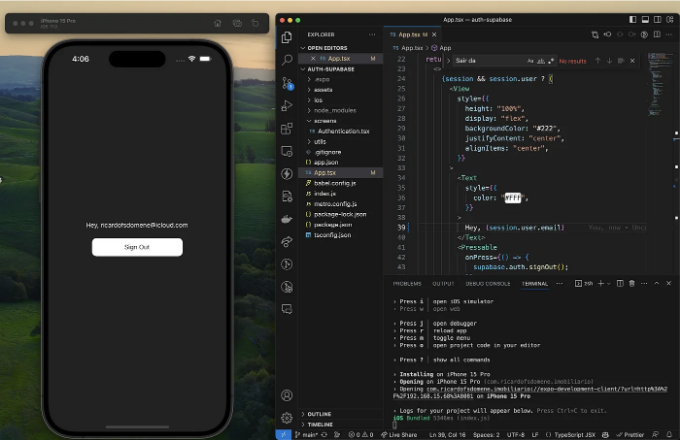
마무리
이 글에서는 Expo를 사용하여 React Native 앱에 Supabase 인증을 통합하는 과정을 살펴보겠습니다. 제공된 단계별 지침을 따르면 모바일 애플리케이션에 인증 기능을 쉽게 추가하여 보안 및 사용자 경험을 향상시킬 수 있습니다.
왜 Supabase가 좋은 선택인가?
Supabase는 여러 가지 이유로 개발자들에게 강력한 도구로 두드러지는데요:
- 사용 편의성: Supabase는 사용자 친화적인 인터페이스와 간단한 설정 프로세스를 제공하여 초보자들에게도 쉽게 접근할 수 있습니다.
- 확장성: 어플리케이션이 성장함에 따라 Supabase는 성능을 희생하지 않고도 요구사항을 충족시키기 위해 손쉽게 확장될 수 있습니다.
- 실시간 기능: Supabase는 실시간 기능을 기본으로 제공하여 동적이고 인터랙티브한 어플리케이션을 구축할 수 있습니다.
- 오픈 소스: 오픈 소스인 Supabase는 투명성과 유연성을 제공하여 플랫폼을 사용자 정의하고 기여할 수 있도록 합니다.
- 포괄적인 문서: Supabase는 포괄적인 문서와 커뮤니티 지원을 제공하여 성공을 위해 필요한 모든 리소스를 확보할 수 있습니다.
Supabase를 인증 수단으로 선택함으로써 당신의 React Native 앱을 크게 향상시킬 수 있는 강력하고 확장 가능하며 개발자 친화적인 솔루션을 선택하게 됩니다.
먼저 이 인증 플로우를 복제하려면 Supabase 계정과 프로젝트가 필요합니다.
React Native Expo 애플리케이션을 설정하려면 터미널(맥 또는 리눅스 사용자)이나 명령 프롬프트(윈도우 사용자)에서 다음 명령을 실행하세요.
참고: Node.js가 필요합니다.
npx create-expo-app -t expo-template-blank-typescriptbash
이제 React Native Expo 애플리케이션이 준비되었습니다. 실행하려면 터미널에서 다음 명령을 실행하세요.
cd yourApplicationName && npx expo start
이제 애플리케이션이 실행 중입니다. 동일한 터미널에서 QR 코드를 스캔하여 전화기에서 테스트할 수 있습니다 (기기와 전화기가 동일한 네트워크에 연결된 경우에만 작동합니다). 또는 현재 사용 중인 OS에 따라 iOS 또는 Android 에뮬레이터에서 애플리케이션을 실행할 수도 있습니다.
이제 Supabase에서 필요한 종속성을 설치해 봅시다:
npx expo install @supabase/supabase-js @react-native-async-storage/async-storage react-native-elements react-native-url-polyfill
import "react-native-url-polyfill/auto";
import AsyncStorage from "@react-native-async-storage/async-storage";
import { createClient } from "@supabase/supabase-js";
const supabaseUrl = "";
const supabaseAnonKey = "";
export const supabase = createClient(supabaseUrl, supabaseAnonKey, {
auth: {
storage: AsyncStorage,
autoRefreshToken: true,
persistSession: true,
detectSessionInUrl: false,
},
});
screens/Authentication.tsx
import React, { useState } from "react";
import { Alert, StyleSheet, View, AppState } from "react-native";
import { Button, Input } from "react-native-elements";
import { supabase } from "../utils/supabase";
// Supabase Auth에서 세션을 자동으로 지속적으로 새로고침하도록 지시합니다.
// 앱이 활성 상태인 경우, 사용자의 세션이 종료되면 'onAuthStateChange' 이벤트를 계속
// 받게됩니다. 'TOKEN_REFRESHED' 또는 'SIGNED_OUT' 이벤트가 발생합니다.
// 이는 한 번만 등록해야 합니다.
AppState.addEventListener("change", (state) => {
if (state === "active") {
supabase.auth.startAutoRefresh();
} else {
supabase.auth.stopAutoRefresh();
}
});
export default function Authentication() {
const [email, setEmail] = useState("");
const [password, setPassword] = useState("");
const [loading, setLoading] = useState(false);
async function signInWithEmail() {
setLoading(true);
const { error } = await supabase.auth.signInWithPassword({
email: email,
password: password,
});
console.log("에러", error);
if (error) Alert.alert(error.message);
setLoading(false);
}
async function signUpWithEmail() {
setLoading(true);
const {
data: { session },
error,
} = await supabase.auth.signUp({
email: email,
password: password,
});
if (error) Alert.alert(error.message);
if (!session) Alert.alert("이메일 인증을 위해 받은 메일함을 확인해주세요!");
setLoading(false);
}
return (
<View style={styles.container}>
<View style={[styles.verticallySpaced, styles.mt20]}>
<Input
label="이메일"
leftIcon={{ type: "font-awesome", name: "envelope" }}
onChangeText={(text) => setEmail(text)}
value={email}
placeholder="email@address.com"
autoCapitalize={"none"}
/>
</View>
<View style={styles.verticallySpaced}>
<Input
label="비밀번호"
leftIcon={{ type: "font-awesome", name: "lock" }}
onChangeText={(text) => setPassword(text)}
value={password}
secureTextEntry={true}
placeholder="비밀번호"
autoCapitalize={"none"}
/>
</View>
<View style={[styles.verticallySpaced, styles.mt20]}>
<Button title="로그인" disabled={loading} onPress={() => signInWithEmail()} />
</View>
<View style={styles.verticallySpaced}>
<Button title="가입하기" disabled={loading} onPress={() => signUpWithEmail()} />
</View>
</View>
);
}
const styles = StyleSheet.create({
container: {
marginTop: 40,
padding: 12,
},
verticallySpaced: {
paddingTop: 4,
paddingBottom: 4,
alignSelf: "stretch",
},
mt20: {
marginTop: 20,
},
});
App.tsx
import { StatusBar } from "expo-status-bar";
import { Pressable, StyleSheet, Text, View } from "react-native";
import Home from "./screens/Authentication";
import { supabase } from "./utils/supabase";
import { useEffect, useState } from "react";
import { Session } from "@supabase/supabase-js";
import Authentication from "./screens/Authentication";
export default function App() {
const [session, setSession] = (useState < Session) | (null > null);
useEffect(() => {
supabase.auth.getSession().then(({ data: { session } }) => {
setSession(session);
});
supabase.auth.onAuthStateChange((_event, session) => {
setSession(session);
});
}, []);
return (
<>
{session && session.user ? (
<View
style={{
height: "100%",
display: "flex",
backgroundColor: "#222",
justifyContent: "center",
alignItems: "center",
}}
>
<Text
style={{
color: "#FFF",
}}
>
Hey, {session.user.email}
</Text>
<Pressable
onPress={() => {
supabase.auth.signOut();
}}
style={{
marginTop: 20,
display: "flex",
justifyContent: "center",
alignItems: "center",
height: 40,
width: 200,
backgroundColor: "#FFF",
borderRadius: 10,
}}
>
<Text
style={{
color: "#333",
}}
>
Sign Out
</Text>
</Pressable>
</View>
) : (
<Authentication />
)}
<StatusBar style="light" />
</>
);
}
const styles = StyleSheet.create({
container: {
flex: 1,
backgroundColor: "#fff",
alignItems: "center",
justifyContent: "center",
},
});
초기 React Native Expo 앱에서 Supabase Authentication을 시작하는 데 도움이 되었기를 바래요! 코딩을 즐기세요! 칭찬해 주세요!